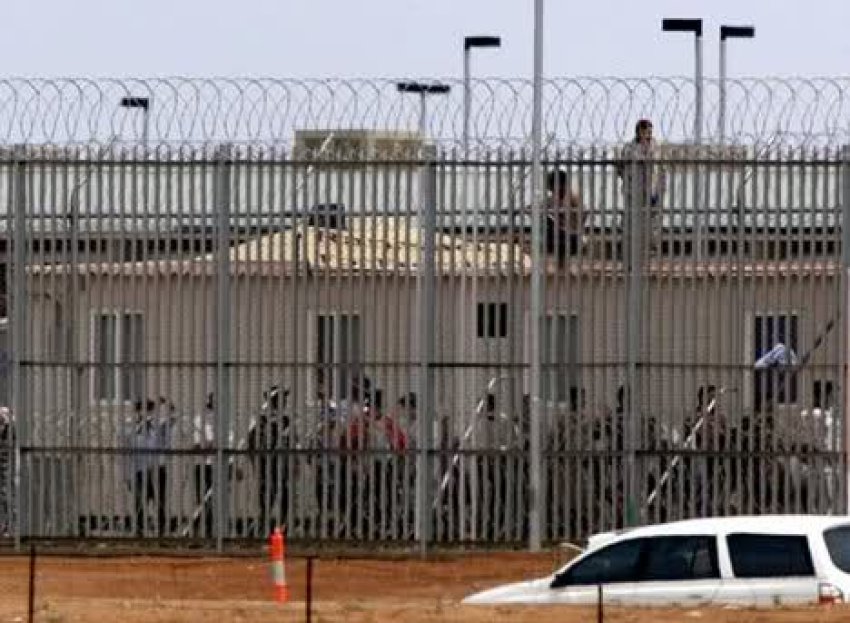
About 300 refugees at the maximum security Red Compound in Christmas Island’s detention centre were fired on with tear gas and modified shotgun rounds during protests over the weekend of March 12-13. One man was hospitalised with a broken leg.
The incident prompted outrage from refugee advocates over the government’s use of force against people seeking Australia’s protection.
The assault occurred after two breakouts from the detention centre. Late on March 11, about 70 Iranian and Iraqi refugees toppled a fence of the Christmas Island detention centre and broke out. Another group, of fewer that 100 men, escaped 12 hours later.
The breakouts were a protest against the overcrowded conditions and long delays now chronic in Australia’s refugee detention system.
Some protesters gathered on the roadside with a banner. Others trekked ten kilometres across bushland and camped on the tarmac of the island’s airport. A third group was said to have visited the local mosque.
Christmas Island shire president Gordon Thomson said the refugees had posed no threat to others on the island, and only wanted to be heard and assisted.
Thomson, who met with eight protesters during their breakout, told ABC radio: “Their purpose is to go out into the community, establish a presence, be seen, be heard and ask that the Australian community understands that they are very frustrated at the long delays in processing their claims for asylum.”
Yet Serco, a private prison operator that runs the detention centre, and the immigration department responded by flying an extra 57 federal police officers to the island with a suite of “less lethal munitions”, including tear gas and modified shot guns to detain the protesters once more.
All was reported peaceful as some refugees were found or returned to the detention centre. It remained calm until Serco guards and federal police handcuffed about 20 escapees alleged to be “ringleaders” and took them to the detention centre’s Red Compound, a maximum security building of isolated concrete cells.
The detention centre erupted and about 300 men forced their way into the compound in a show of solidarity. Federal police fired on the unarmed protesters with tear gas and modified shotgun rounds.
Initial reports said the guards had used rubber bullets. However, on March 14 Lateline said “beanbag” bullets were used — cartridges containing pillows filled with shot gun pellets.
Immigration minister Chris Bowen said: “there were no serious injuries” but cited “damage to property” as reason for the force used by AFP.
But one refugee was taken to hospital with a broken leg, which Lateline said was most likely caused by rubber bullets or the beanbag rounds.
Beanbag bullets are a weapon of choice for US police for “crowd control” and to quell individuals who may be a danger to themselves or others. Guidelines say its intended purpose is to “incapacitate” or cause disabling pain to extreme discomfort.
The rounds can cause severe welts and cuts, but also fractures and — if victims are fired in the face — blindness and skull fractures.
Police fired on refugees with tear gas again on March 18 after unrest broke out again. This time, however, detainees set fire to parts of the compound, mostly to the tents many lived in due to bed shortages.
About 250 people were involved said ABC Online. Bowen said the immigration department could revoke the refugees’ visas on “character grounds,” despite the fact that many are already recognised refugees.
After the first protest, the government said the use of tear gas was necessary because the refugees were “violent”. But while Bowen said the use of force by Serco guards and federal police was “reasonable”, he also admitted the violence was triggered after the refugees were handcuffed.
“That is largely true,” he told ABC TV. “There was an effort undertaken to ensure that those who were organising the protest were effectively handled and that did lead to the other protesters engaging in violent activity.”
Refugee advocate Jamal Daoud from the Social Justice Network said the police rough-handled refugees who had remained completely peaceful and compliant until then.
“They know that there is no possibility to escape from a remote island. But they just wanted to send a message, a protest, and they wanted somebody to hear them,” he told ABC radio on March 14.
The Refugee Action Coalition in Sydney said one of the refugees who broke out on March 11 said: “We thought maybe we have achieved all we could. We didn’t want a confrontation with the police.”
Bowen announced an independent review of the events. He admitted they were sparked by “frustrations” over prolonged and unjustified detention, but said the protests would not “change visa outcomes”.
“People who protest to try and change their visa outcome … do not achieve anything. They simply slow the process.”
The government is responsible for an outrageous abuse of human rights. It admitted to the authorised use of weapons against unarmed refugees it has kept locked in overcrowded conditions for indefinite periods. It also admitted that Serco and the police turned the peaceful demonstrations violent.
The Iraqi, Iranian and Tamil men who broke out have fled persecution and violence in their countries and sought Australia's protection. They now face further violence and abuse in a country that supposedly upholds a "compassionate" refugee system. This lie is now open for the world to see.
Comments
Anonymous replied on Permalink